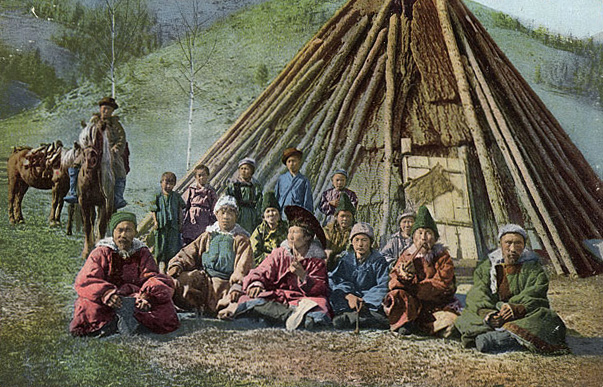|
Taptuk Emre
Taptuk Emre (b. 1210-1215 - d. ?), a Turkmen mystic and Sufi shaykh from amongst the Khorasani saints, and the mentor/murshid of Yunus Emre. He was from Khorasan and came to Anatolia during the reign of Genghis Khan to spread the Bektashi style of the Qur'an and the Ahl al-Bayt creed, that is, the belief in Muhammad and the Twelve Imams. He is thought to have been born between 1210 and 1215. Many sources point out that he was a Babai-Haydari dervish. He is the successor of Barak Baba, but Bektashis claim he was the successor of Haji Bektash Veli. It is said that Hacı Bektaş-ı Veli left the job of raising Yunus Emre to Taptuk Emre. Starting with Tapduk Emre, the existence of a community of followers of Tapduk has been encountered in Anatolia. Dervish Yunus, who carried wood to Taptuk Emre's dergah in Nallıhan for forty years, is regarded as one of the greatest bards/poets raised by the ascetics of Anatolia. Although the exact location of Tapduk Emre's grave has not been d ... [...More Info...] [...Related Items...] OR: [Wikipedia] [Google] [Baidu] |
Anatolian Beyliks
Anatolian beyliks (, Ottoman Turkish: ''Tavâif-i mülûk'', ''Beylik''; ) were Turkish principalities (or petty kingdoms) in Anatolia governed by ''beys'', the first of which were founded at the end of the 11th century. A second and more extensive period of establishment took place as a result of the decline of the Seljuq Sultanate of Rûm in the latter half of the 13th century. One of the ''beyliks'', that of the ''Osmanoğlu'' of the Kayı branch of Oghuz Turks, from its capital in Bursa completed its incorporation of the other ''beyliks'' to form the Ottoman Empire by the late 15th century. The word ''beylik'' denotes a territory under the jurisdiction of a ''bey'', equivalent to a duchy or principality in other parts of Europe. History Following the 1071 Seljuk victory over the Byzantine Empire at the Battle of Manzikert and the subsequent conquest of Anatolia, Oghuz Turkic clans began settling in present-day Turkey. The Seljuk Sultanate of Rum's central powe ... [...More Info...] [...Related Items...] OR: [Wikipedia] [Google] [Baidu] |
Twelve Imams
The Twelve Imams (, '; , ') are the spiritual and political successors to the Islamic prophet Muhammad in the Twelver branch of Shia Islam, including that of the Alawite and Alevi. According to Twelver theology, the Twelve Imams are exemplary human individuals who not only rule over the community with justice, but also are able to keep and interpret '' sharia'' and the esoteric meaning of the Quran. The words and deeds of Muhammad and the imams are a guide and model for the community to follow; as a result, they must be free from error and sin (known as '' ismah'', or infallibility) and must be chosen by divine decree through Muhammad. Imamah It is believed in Twelver Shi’ism that the Islamic prophet Muhammad and his household are infallible, possessing '' Hikmah''. Their oppression and suffering served greater purposes and were a means of divine grace to their devotees. The Imams are also guided by preserved texts in their possession, such as al-Jafr, al-Jamia ... [...More Info...] [...Related Items...] OR: [Wikipedia] [Google] [Baidu] |
Altai People
The Altai people (, ), also the Altaians (, ), are a Turkic peoples, Turkic ethnic group of indigenous peoples of Siberia mainly living in the Altai Republic, Russia. Several thousand of the Altaians also live in Mongolia (Altai Mountains) and China (Altay Prefecture, Xinjiang) but are Unrecognized ethnic groups in China, not officially recognized as a distinct group and listed under the name "Oirats" as a part of the Mongols, as well as in Kazakhstan where they number around 200. For alternative ethnonyms see also Tiele people, Tele, Qarai Turks, Black Tatar, and Oirats. During the Northern Yuan, Northern Yuan dynasty, they were ruled in the administrative area known as Telengid Province. Ethnic groups and subgroups The Altaians are represented by two ethnographic groups: * The Northern Altaians, who speak the Northern Altai language and dialects, include the Chelkans, Kumandins, and Tubalars (Tuba-Kizhi). * The Southern Altaians, who speak the Southern Altai language with i ... [...More Info...] [...Related Items...] OR: [Wikipedia] [Google] [Baidu] |
Afyonkarahisar
Afyonkarahisar (, 'poppy, opium', ''kara'' 'black', ''hisar'' 'fortress') is a major city in western Turkey. It is the administrative centre of Afyonkarahisar Province and Afyonkarahisar District. Its population is 251,799 (2021). Afyon is in the mountainous countryside inland from the Aegean Sea, Aegean coast, south-west of Ankara along the Akarçay River. In Turkey, Afyonkarahisar stands out as a capital city of hot springs and spas, an important junction of railway, highway and air traffic in West-Turkey, and the place where Turkish War of Independence, independence was won. In addition, Afyonkarahisar is one of Turkey's leading provinces in agriculture, globally renowned for its marble and is the world's largest producer of pharmaceutical opium. In antiquity, the city was called Akroinon and it is the site of Afyonkarahisar Castle, built around 1350 BC. Etymology The name Afyon Kara Hisar literally means ''opium black fortress'' in Turkish language, Turkish, since opium was wi ... [...More Info...] [...Related Items...] OR: [Wikipedia] [Google] [Baidu] |
Aksaray
Aksaray () is a city in the Central Anatolia region of Turkey. It is the seat of Aksaray Province and Aksaray District.İl Belediyesi Turkey Civil Administration Departments Inventory. Retrieved 12 January 2023. Its population is 247,147 (2021). In 2021 the province had an estimated population of 429,069 distributed over about . The average elevation is , with the highest point being Mt. Hasan ( Turkish: ''Hasan Dağı'') at . The city of Aksaray has a long history and was an important stopover point on the |
Manisa
Manisa () is a city in Turkey's Aegean Region and the administrative seat of Manisa Province, lying approximately 40 km northeast of the major city of İzmir. The city forms the urban part of the districts Şehzadeler and Yunusemre, with a population of 385,452 in 2022. Modern Manisa is a booming center of industry and services, advantaged by its closeness to the international port city and the regional metropolitan center of İzmir and by its fertile hinterland rich in quantity and variety of agricultural production. In fact, İzmir's proximity also adds a particular dimension to all aspects of life's pace in Manisa in the form of a dense traffic of daily commuters between the two cities, separated as they are by a half-hour drive served by a fine six-lane highway nevertheless requiring attention at all times due to its curves and the rapid ascent (sea-level to more than 500 meters at Sabuncubeli Pass) across Mount Sipylus's mythic scenery. The historic part of Manisa s ... [...More Info...] [...Related Items...] OR: [Wikipedia] [Google] [Baidu] |
Nevşehir
Nevşehir (; from 'new' and 'city') is a city in the Central Anatolia Region of Turkey. It is the seat of Nevşehir Province and Nevşehir District.İl Belediyesi Turkey Civil Administration Departments Inventory. Retrieved 22 May 2023. Its population is 128,290 (2024). It is from the capital Ankara and lies within the historical region of Cappadocia. Nevşehir Province, Nevşehir was declared a World Peace City by the United Nations. The town lies at an elevation of and has a continental climate, with heavy snow in winter and great heat in summer. Although Nevşehir is close to the underground cities, fairy chimneys, monasteries, caravanserais and rock-hewn churches of Cappadocia, and has a few hotels, the modern town is not itself a tourist centre. In 2015 a huge underground city was discovered ... [...More Info...] [...Related Items...] OR: [Wikipedia] [Google] [Baidu] |
Eskişehir
Eskişehir ( , ; from 'old' and 'city') is a city in northwestern Turkey and the capital of the Eskişehir Province. The urban population of the city is 821 315 (Odunpazari + Tebebasi), with a metropolitan population of 921 630. The city is located on the banks of the Porsuk River, 792 m above sea level, where it overlooks the fertile Phrygian Valley. In the nearby hills one can find hot springs. The city is to the west of Ankara, to the southeast of Istanbul and to the northeast of Kütahya. It is located in the vicinity of the ancient city of Dorylaeum. Known as a college town, university town, it houses Eskişehir Technical University, Eskişehir Osmangazi University, and Anadolu University. The province covers an area of . Etymology The name can be literally translated as 'Old City' in Turkish language, Turkish. The name has been documented in Ottoman records since the late 15th century. History The city was founded by the Phrygians in at least 1000 Anno Domini, ... [...More Info...] [...Related Items...] OR: [Wikipedia] [Google] [Baidu] |
Ascetic
Asceticism is a lifestyle characterized by abstinence from worldly pleasures through self-discipline, self-imposed poverty, and simple living, often for the purpose of pursuing spiritual goals. Ascetics may withdraw from the world for their practices or continue to be part of their society, but typically adopt a frugal lifestyle, characterised by the renunciation of material possessions and physical pleasures, and also spend time fasting while concentrating on the practice of religion, prayer, or meditation. Some individuals have also attempted an ascetic lifestyle to free themselves from addictions to things such as alcohol, tobacco, drugs, entertainment, sex, food, etc. Asceticism has been historically observed in many religious and philosophical traditions, most notably among Ancient Greek philosophical schools (Epicureanism, Gymnosophism, Stoicism, and Pythagoreanism), Indian religions (Buddhism, Hinduism, Jainism), Abrahamic religions (Christianity, Judaism, Islam), an ... [...More Info...] [...Related Items...] OR: [Wikipedia] [Google] [Baidu] |
Bards
In Celtic cultures, a bard is an oral repository and professional story teller, verse-maker, music composer, oral historian and genealogist, employed by a patron (such as a monarch or chieftain) to commemorate one or more of the patron's ancestors and to praise the patron's own activities. With the decline of a living bardic tradition in the modern period, the term has loosened to mean a generic minstrel or author (especially a famous one). For example, William Shakespeare and Rabindranath Tagore are respectively known as "the Bard of Avon" (often simply "the Bard") and "the Bard of Bengal".Oxford Dictionary of English, s.v. ''bard'', n.1. In 16th-century Scotland, it turned into a derogatory term for an itinerant musician; nonetheless it was later romanticised by Sir Walter Scott (1771–1832). Etymology The English term ''bard'' is a loan word from the Celtic languages: Gaulish: ''bardo-'' ('bard, poet'), and ('bard, poet'), ('singer, poet'), Middle Breton: ''barz'' ... [...More Info...] [...Related Items...] OR: [Wikipedia] [Google] [Baidu] |
Nallıhan
Nallıhan is a municipality and district of Ankara Province, Turkey. Its area is 2,079 km2, and its population 26,553 (2022). It is 157 km from the city of Ankara. Its elevation is 625 m. Nallıhan is one of many towns that claim to be the burial place of Taptuk Emre, who lived in the 12-13th century, and was the teacher of the popular folk poet and dervish Yunus Emre. Nallıhan ''Davutoğlan Bird Paradise'' attracts local and foreign tourists. Name Nallıhan is named after a caravanserai on the ancient Silk Road to the Orient next to the river ''Nallı''. There has been a settlement here for thousands of years. Today Silk farming, a tradition for centuries in Nallıhan, continues in many homes. Today, the town is known for its silk needlework, and local cuisine including stuffed vine-leaves, pilav, pumpkin dessert, gozleme (flat bread with cheese and potatoes filling), and many other types of more fine pastries such as baklava with locally grown walnut. The ... [...More Info...] [...Related Items...] OR: [Wikipedia] [Google] [Baidu] |






